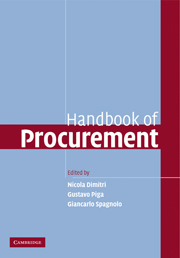Book contents
- Frontmatter
- Contents
- List of figures
- List of tables
- List of contributors
- Preface
- Part I Preliminary Issues
- 1 Introduction
- 2 The variety of procurement practice: evidence from public procurement
- Part II General Strategic Principles
- Part III Competitive Tendering Strategies
- Part IV Attracting and Screening Participants
- Part V Preventing Collusion and Corruption
- Part VI Dynamic Forces and Innovation
- Glossary
- Index
1 - Introduction
Published online by Cambridge University Press: 04 November 2009
- Frontmatter
- Contents
- List of figures
- List of tables
- List of contributors
- Preface
- Part I Preliminary Issues
- 1 Introduction
- 2 The variety of procurement practice: evidence from public procurement
- Part II General Strategic Principles
- Part III Competitive Tendering Strategies
- Part IV Attracting and Screening Participants
- Part V Preventing Collusion and Corruption
- Part VI Dynamic Forces and Innovation
- Glossary
- Index
Summary
Why a handbook on procurement?
Procurement represents a very large fraction of total economic activity. The value of public procurement transactions in EU countries is about 16 percent of their GDP, while in the United States it is around 20 percent. In the private sector, the value of transactions is even larger and is steadily increasing, due to the current trend towards outsourcing all non-core business activities.
Efficient procurement is therefore a core necessity for firms’ profitability and survival, and for the public sector's effectiveness in obtaining resources for social spending and/or lower taxes. Procurement design directly and substantially affects firms’ and countries’ performance in the short and in the long run: in the short run, most obviously by immediately determining the costs and quality of inputs in the private or public supply chains; in the long run, most importantly by determining suppliers’ and more generally firms’ incentives to invest in R&D and to innovate in general.
Procurement design and management is a complex issue though, as contractual problems directly interact with competitive screening and risk management problems. Moreover, procurement is most often a dynamic, repeated activity, with short-term objectives often conflicting with long-term ones. Strategic procurement decisions must be taken with a focus on the future dynamics of the demand–supply relationship. Neglecting the importance of repeated relationships with potential suppliers and the effects of procurement choices on an industry or a district dynamic could have very undesirable consequences for a large buyer, in terms of both price and quality.
- Type
- Chapter
- Information
- Handbook of Procurement , pp. 3 - 13Publisher: Cambridge University PressPrint publication year: 2006
- 3
- Cited by



